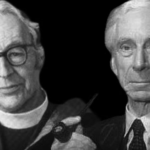Coming to Our Senses: The Moral Sense of Scripture
NOTE: Over the past several months, we've had lots of combox discussion about how Catholics read and interpret the Bible. To help us all make sense of this question, we began a multi-part series on the topic. Once a week, for the next several weeks, Mark Shea will unpack how Catholics authentically read the Bible. He began with a general introduction, then he outlined three specific guidelines. Last week he launched into the three main spiritual senses (or lenses) through which Catholics interpret the Bible by focusing on the allegorical sense. Today, he'll cover the moral and next week conclude with the anagogical.
Discussing the moral sense of Scripture should seem easy. After all, we’re talking "The Good Book" here. Even when many Americans abandoned Christianity as supernatural revelation from God, they for the past couple generations still tended to treat the Bible as a solid moral code with some lingering respectability. Martin Luther King, Jr. could still appeal to it and not get hooted off the stage as recently as 40 years ago.
But the cultural consensus about the goodness of the Good Book is rapidly decaying and, for many people, it is no longer taken for granted that “the moral sense of scripture” is even a good thing. But whether they approach the Bible as the Good Book or the Bad Book, there’s one thing most of our fellow post-moderns can agree on it: it is primarily a Rule Book.
That’s just one of the many ways in which contemporary culture demonstrates its misunderstanding of Scripture. For it is not too far off the mark to say that Christ came into the world specially to destroy the notion that salvation is predicated on following the Rules and Morality.
So if the Bible is not all about law and morality, why the Ten Commandments and all the rules and regs? The basic answer of the Tradition is that laws and morality are sort of like x-rays. They are part of the healing process, but they do not heal anything. The laws and morality side of the Bible are the x-ray equipment of the Divine Physician. The law says stuff like “Don’t covet. Be generous.” and then, when you act like the squeezing, wrenching, grasping, covetous old sinner you are, you find you are breaking the law. But that’s all the law can do: tell you what’s wrong with you. It’s can’t get you an inch nearer to healing the problem with your soul once you’ve looked at the x-rays. Only Christ can do that—which is why the Bible is actually all about him, not about rules and regulations.
This does not, of course, mean Catholics say “Whee! New Testament, New Covenant! No rules! Go nuts!” It means that for us Christ is the reality while the laws, rules, and regulations of the Old Testament were, so to speak, just the shadow pointing to him. The lesson of the Old Testament, in a hundred ways, is that purity matters. And the Old Testament gets this across by making no specially strong distinctions between the “ick” created by our revulsion to sin and the “ick” created by our revulsion at eating foods that gross us out. The moral is not “God hates bacon”. The moral is “God hates sin the way you, O Israel, hate the thought of eating pork.” Eventually, once the central lesson has been learned about the sin business, Christ will make clear that we are not defiled by anything that enters the belly, but only by the evil that comes out of the heart. His solution is not “Down with rules!” but rather to give us the power to obey God and keep the law. So faith in Christ does not “free” us from obeying God, just as love does not “free” us from binding ourselves to our spouse. Rather, faith “establishes” the law of God by making us both desire to do it and able to do it.
That’s why the New Testament still commands us to do various things (starting with keeping the Ten Commandments). The point is not that the Ten Commandments will save you, but rather that saved people live as God wants them to live so that they can experience the fulness of the life of the Trinity. Living out the commands to love God and love neighbor, they will find themselves keeping the whole of the law and the prophets.
Because of this, the Church has always looked to Scripture to convey a “moral sense”: that is to communicate ways in which an authentic follower of Jesus Christ should live. This includes not merely the standard didactic moral teaching of the Judeo-Christian tradition (“Love your enemies, pay your taxes, don’t gossip, avoid impurity” etc.), but also various ways in which Christ is again “hidden” in the Old Testament.
What this presumes is that Christ teaches by means of icon as well as word. The reason the Church believes this is because Christ does, in fact, give us an example of iconographic teaching when he strips, ties a towel around his waist, and proceeds to wash the feet of the disciples on Maundy Thursday. He offers us a picture rather than a preachment and tells us to do likewise. The Church, following this clue, does what we all do when reading a familiar tale and starts seeing moral lessons elsewhere. For instance, she (like every first grader on planet earth) sees a moral lesson about courage in the face of overwhelming odds in the tale of David and Goliath. Reading the story of Daniel in the Lion’s Den, we see a moral image of the faith required by a disciple of Christ when we too are surrounded by lions of fear, despair, doubt, and discouragement. When we look at the Temple, Paul tells us that we are looking at an image of our own body and that we must not defile it. He gets that connection from his Master, who likewise said of his body, “Destroy this temple and in three days I will raise it up.”
Scripture is more or less a bonanza of this sort of imagery and, again, we can ransack it at will just so long as the moral teachings we see illustrated there do not contradict what the Church teaches about, you know, morals.
Which, of course, raises a question since morals in both Scripture and in the history of the Church develop. Psalm 137 pronounces a blessing on anybody who would smash a Babylonian babies brains out on a rock. Christ? Not so much. Slavery used to be sort of reluctantly okay for Christians (cf. Philemon). Now? No.
Of course, a postmodern who is simply mining Scripture for “contradictions” will often dismiss the whole thing as rubbish. However, those in our culture who still retain something like an historical imagination will consider the possibility that precisely the problem facing the Christian description of revelation is that it involved eternity breaking into time and the Perfect revealing himself to the radically imperfect. Among other things, this means that our grasp of what God is saying to us could well take all of human history and beyond to fully see what is going on. So it would seem to me quite on the cards that when God reveals himself to a bunch of Bronze Age savages, he will likely be understood in Bronze Age savage terms involving such matters as herem—the ancient Semitic practice of slaying everybody and everything in a village as, ironically, a pious act (“See Lord! I’m keeping nothing for myself!”). One need not, I think, believe that God desires such things to see that he could use such cultural flotsam in a long-term effort (a successful one, by the way) to move Israel away from such barbarism and ultimately to the revelation of Christ, who offers Himself as a sort of burnt offering to save us from our sinful barbarism.
Because of all this, I don’t think we can embrace any of three simple solutions to the moral complexity of Scripture. That is, we cannot simply: 1) deny the inspired character of those texts of Scripture we happen to find distasteful or troubling; 2) explain away the literal sense of Scripture by allowing some symbolic reading of it to predominate; or 3) simply affirm wholesale all Old Testament morality from hamstringing horses to stoning rebellious adolescents to butchering Canaanite babies as “the will of God.” Rather, we must be very cautious in searching through Scripture for its moral sense because the morality taught by Scripture is not a static thing.
Consider a human embryo. At one point it has a tail. But the adult human doesn’t. Is it really accurate to say humans are creatures with tails? No, even though at one stage in the womb we were. The same principle applies here. Revelation progressed like a developing embryo from the Old Testament to the New. God permitted divorce under the Mosaic Covenant, for instance. Yet Jesus would later make clear that this was a permission, not “God’s will” (Mark 10:5). Similarly, God condescended to the practice of the culture to which He first revealed Himself when He “stooped down” and submitted Himself to the practice of “cutting a covenant” with Abraham by passing between the severed halves of the animal carcasses (Genesis 15). But though God blessed forms of sacrifice and covenant which were perfectly acceptable in Abraham’s day, His ultimate goal was always to lead us to the final and full sacrifice and covenant offered by Christ. In the same way, there were moral, ethical, and philosophical insights in Abraham’s day which were good as far as they went, but they have since been fulfilled and completed by the final and full revelation offered by Christ
Consider also the Jewish understanding of the afterlife. Ecclesiastes tells us that “life is vanity” and speaks in a despairing tone about the futility of earthly existence. That is because Ecclesiastes is unaware of the resurrection of the Body which was not fully revealed until later. The author is right as far as he goes. Earthly life is futile. He simply doesn’t (and can’t) go far enough without further revelation.
Bottom line: Much Old Testament morality and theology regarding war, marriage, the afterlife, justice, and so forth is true as far as it goes, but often the author has not yet gone far enough because the Holy Spirit has not yet revealed it. In the Old Testament, the Chosen People were not yet the recipients of full revelation. That full revelation was Jesus Christ, who definitively clarified all that went before and fulfilled what was not complete. This is the idea of the development of doctrine. We understand this idea completely when we contemplate our own children. There are things we permit of (and punishments we inflict on) three year olds that are appropriate for their stage of development which would be absurd to permit of (or inflict on) a 20-year-old.
In short, in revealing himself “in time and on earth” God is obliged to work through and with a people with faults, idiosyncrasies, blind spots, and errors resulting from their being as fallen as the rest of the human race. Yet he is obliged to do so, not in order to ratify the Fall, but in order to mend it. This meant, as all teachers know, making allowances for the weaknesses of the student till the student matured further. It meant facing the fact that the world into which Israel marched out of Egypt was a real world, not an ideal one, and that facing that world (a world where idolatry, wars of extermination, child sacrifice, polygamy, and other such complicating features were the norm for all participants) would mean a long, hard road to building a civilization and an even longer road to the day when the human race was ready to hear the (at the time) unimaginable truth of Christ.
Thus, to complain that God did not immediately introduce the full moral and ethical teaching of Christ into the diet of Israel is like complaining that a parent does not immediately force feed a baby sirloin steak and a bottle of wine. It is like finding fault with a kindergarten teacher for neglecting to introduce the kidlets to the inner mysteries of integral calculus, algebra, and quantum physics. As Christ taught of divorce, so it may be said of many of the moral imperfections permitted in the Old Testament: “For your hardness of heart he wrote you this commandment” (Mark 10:5). It was not that God changed from the Old Testament to the New. It was that we had to grow up enough to bear the full truth about him and his demands on us. Our eyes have to get used to the Light.
Related Posts
Note: Our goal is to cultivate serious and respectful dialogue. While it's OK to disagree—even encouraged!—any snarky, offensive, or off-topic comments will be deleted. Before commenting please read the Commenting Rules and Tips. If you're having trouble commenting, read the Commenting Instructions.













